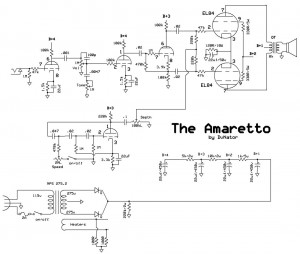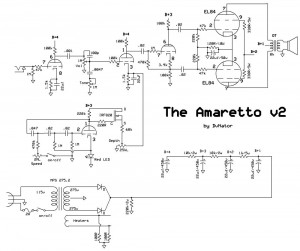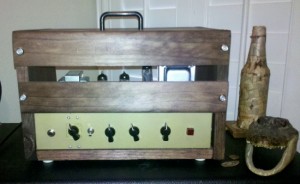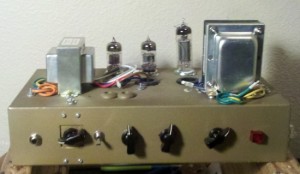![]()
This is my last Valve Junior chassis and it’s another 2x EL84 amp. This amp has gone through a TON of changes. It’s had LTP, paraphase and now a cathodyne PI as well as all sorts of tone controls and other preamp changes. I think I finally have something I’m going to stick with.
The amp ended up being very close to a Brown Princeton 6G2. What I was going for was along the lines of a 6G2 done in a more Matchless/Vox way. I think it came out really well.
Basically the amp starts with one triode of a 6N2P set up like the first triode of an AC30. Then it goes to the volume control and a simple treble bleed tone control. Another gain stage drives the cathodyne phase inverter which then drive a pair of EL84s.
So that leaves an extra triode and we can’t have that going to waste! I used the extra triode to do a bias wiggle trem which sounds great. I started with the tremolo from a Gibson amp then messed around a little with the components taking inspiration from Fender and Matchless amps.
I experimented with the cathodyne phase inverter some more with this amp. I think the key to getting the cathodyne to sound more like a LTP is to basically increase the value of just about everything compared to the 5E3 version. I’ve found increasing the grid stoppers on the power tubes get rid of most of the raunchiness from the cathodyne. Also increasing the bias resistor helps firm up the bass and makes the high end more pronounced like colder biased stages do. Then there is adding the big grid stopper before the PI per Merlin to help when the cathodyne is overdriven.
For the power transformer I’m using a PT275.2 from Musical Power Supplies. The output transformer is a OT15PP, also from Musical Power Supplies.
The amp has a really nice clean tone and the overdrive is nice too. This amp definately has a Vox sort of thing happening and the tremolo adds a whole other dimension. This is one of the few amps my wife actually complimented the tone. There’s a big complex and chimey tone to it and a different sound to it than other amps I’ve built. I like doing something other than the same old thing.
Here is the original schematic:
I’ve since changed the tremolo. The bias wiggle trem works but it’s not as effective as it could be with a cathode biased amp. I tried a few different things and ended up going with the basic design of the trem in a Fender Vibro Champ. I’m using a MOSFET as a cathode (source) follower instead of a triode. This trem has a bigger effect sounds really good. Based on a suggestion on wattkins.com I’m also using a red LED to bias the trem.
This is the updated schematic:
Did another update…
This is almost a whole new design but I went with a LTP phase inverter, and fixed bias. With fixed bias the trem is really strong and sounds good. I think the fixed bias also make the sound a little more lively and really “pop”. And I mean pop in a good way.





Hi there, I am going to try and build something like your Amaretto, this will be my first scratch built amp. I wonder if you could help by telling me the expected voltages at B+1, B+2, B+3 and B+4?.
Many thanks, Pete
I don’t think I made note of the voltages but I think there was about 345v on the plates. 18 watt transformers would likely work well.
Good luck with the build!
Great design! Samples, please!!!
Thanks but I’ve since done a little more rework on this one. It now has a LTP PI with fixed bias and the trem is back to wobbling the power tubes. The fixed bias make the sound “pop” a bit more and makes the trem very effective.
I might try to get some samples of it in the near future.
That’s a very cool amp design!
I’m noticing, you must like to run your EL84s very hot with a 120R cathode resistor. Are your output tubes able to cope well?
But I know it is quite common to run these EL84s hot on those type of designs.
On my AC15 clone I have decided to increased the cathode resistor to 180R as I don’t like the idea of dissipating more than the specified 12W.
I do like to run cathode biased power tubes hot because I think they usually sound best that way. Maybe not right at 100% dissipation but pretty close.
Can you post a schematic with the updated LTP PI ?
Finally done! See above…